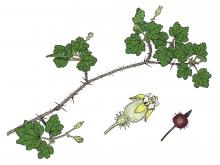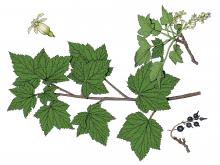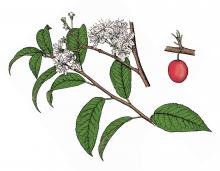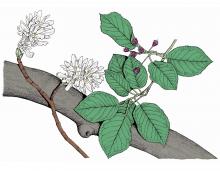Trees, Shrubs and Woody Vines
Media

Species Types
Scientific Name
Rubus allegheniensis
Description
Common blackberry is only one of several species of blackberry in our state. It grows in rocky, open woods, along bluffs and fencerows, on glades, and in thickets, old fields, and open valleys nearly statewide.
Media

Species Types
Scientific Name
Ribes cynosbati
Description
Prickly gooseberry occurs mostly in the eastern half of Missouri. Its spine-covered berries turn reddish purple when ripe. Despite the prickles, they are edible.
Media

Species Types
Scientific Name
Ribes americanum
Description
American black currant is uncommon in Missouri, known from only one location in Schuyler County. The leaves have orange, resinous glands on the undersurface. A spineless shrub, it bears flowers, and later black berries, in clusters of 6–15.
Media

Species Types
Scientific Name
Ribes missouriense
Description
Missouri gooseberry is our state’s most widespread and common gooseberry. People brave its prickly stems to collect its tart, tasty fruits to make pies, jams, and jellies.
Media

Species Types
Scientific Name
Rhus glabra
Description
Colonies of smooth sumac are most noticeable in early autumn, because the leaves turn brilliant red! You can make drinks and jellies from the clusters of fuzzy red berries.
Media

Species Types
Scientific Name
Rhus aromatica
Description
Unlike its cousin poison ivy, fragrant sumac is a peasant, nontoxic plant. Note the middle leaflet of its "leaves of three": On fragrant sumac, there is no (or at most a very short) leaf stalk on that middle leaflet. Also, fragrant sumac has hairy, reddish fruits (not waxy whitish ones).
Media

Species Types
Scientific Name
Prunus americana
Description
A shrub or small tree with clusters of white flowers in the spring, and small, edible, red or yellow fruits in mid- to late summer, wild plum is a popular tree for landscaping.
Media

Species Types
Scientific Name
Amelanchier arborea
Description
Downy serviceberry is a tall shrub or small tree found throughout Missouri in open or rocky woods. It is one of the earliest spring trees to bloom, producing showy white flowers. The springtime flowers, the purplish, often sweet berries, and the brilliant fall color make serviceberry an attractive landscaping tree.
Media

Species Types
Scientific Name
Corylus americana
Description
American hazelnut is a thicket-forming shrub that grows to about 10 feet high. It is prized for its edible nuts, which are covered by a distinctive leafy or papery, jagged-edged bract.
Media

Species Types
Scientific Name
Rhus spp.
Description
Sumacs are shrubs or small trees that often form colonies from their creeping, branched roots. The foliage usually turns brilliant shades of red in early autumn. The clusters of berrylike fruits are red.
See Also
About Trees, Shrubs and Woody Vines in Missouri
There are no sharp dividing lines between trees, shrubs, and woody vines, or even between woody and nonwoody plants. “Wood” is a type of tissue made of cellulose and lignin that many plants develop as they mature — whether they are “woody” or not. Trees are woody plants over 13 feet tall with a single trunk. Shrubs are less than 13 feet tall, with multiple stems. Vines require support or else sprawl over the ground.





















